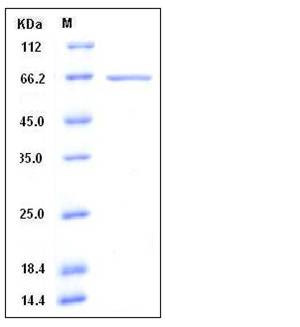Human HDAC3 / Histone deacetylase 3 Protein (His & GST Tag)
HD3,RPD3,RPD3-2
- 100ug (NPP3916) Please inquiry
| Catalog Number | P11511-H20B |
|---|---|
| Organism Species | Human |
| Host | Baculovirus-Insect Cells |
| Synonyms | HD3,RPD3,RPD3-2 |
| Molecular Weight | The recombinant human HDAC3/GST chimera consists of 666 amino acids and has a calculated molecular mass of 76.7 kDa. It migrates as an approximately 66 kDa band in SDS-PAGE under reducing conditions. |
| predicted N | Met |
| SDS-PAGE |  |
| Purity | > 90 % as determined by SDS-PAGE |
| Protein Construction | A DNA sequence encoding the full length of human HDAC3 (O15379-1) (Met 1-Ile 428) was fused with the N-terminal polyhistidine-tagged GST tag at the N-terminus. |
| Bio-activity | |
| Research Area | Signaling |Signal Transduction |Metabolism |Pathways and Processes |Metabolic signaling pathways |Lipid and lipoprotein metabolism | |
| Formulation | Lyophilized from sterile 20mM Tris, 500mM NaCl, 4mM GSH, pH 7.4 1. Normally 5 % - 8 % trehalose and mannitol are added as protectants before lyophilization. Specific concentrations are included in the hardcopy of COA. |
| Background | Histone Deacetylases (HDACs) are a group of enzymes closely related to sirtuins. They catalyze the removal of acetyl groups from lysine residues in histones and non-histone proteins, resulting in transcriptional repression. In general, they do not act autonomously but as components of large multiprotein complexes, such as pRb-E2F and mSin3A, that mediate important transcription regulatory pathways. There are three classes of HDACs; classes 1, 2 and 4, which are closely related Zn2+-dependent enzymes. HDACs are ubiquitously expressed and they can exist in the nucleus or cytosol. Their subcellular localization is effected by protein-protein interactions (for example HDAC-14.3.3 complexes are retained in the cytosol) and by the class to which they belong (class 1 HDACs are predominantly nuclear whilst class 2 HDACs shuttle between the nucleus and cytosol). HDACs have a role in cell growth arrest, differentiation and death and this has led to substantial interest in HDAC inhibitors as possible antineoplastic agents. Histone Deacetylases (HDACs) is Responsible for the deacetylation of lysine residues on the N-terminal part of the core histones (H2A, H2, H3 and H4). Histone deacetylation gives a tag for epigenetic repression and plays an important role in transcriptional regulation, cell cycle progression and developmental events. Histone deacetylases act via the formation of large multiprotein complexes. Probably participates in the regulation of transcription through its binding to the zinc-finger transcription factor YY1; increases YY1 repression activity. Required to repress transcription of the POU1F1 transcription factor. Acts as a molecular chaperone for shuttling phosphorylated NR2C1 to PML bodies for sumoylation. |
| Reference |
